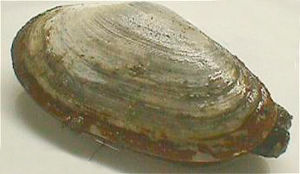Sand gape clam
| Sand gape clam | ||||||||||||
|---|---|---|---|---|---|---|---|---|---|---|---|---|

Sand gape clam |
||||||||||||
| Systematics | ||||||||||||
|
||||||||||||
| Scientific name | ||||||||||||
| Mya arenaria | ||||||||||||
| Linnaeus , 1758 |
The sand clam ( Mya arenaria ) is like its sister species , the truncated clam ( Mya truncata ), a type of clam from the family of the clams (Myidae) in the order of the Myida .
features
The housing , which is slightly unevenly hinged in both species , becomes up to 15 cm long in the sand gape mussel. The right flap is slightly larger and more arched than the left flap. It is elongated-ovoid in outline with a broadly rounded front end, a broadly rounded ventral edge and a narrowly rounded rear end, which is almost angled in the case of the truncated clamshell. It is "unequal": the vertebrae sit a little in front of the center line in relation to the length of the case. The ligament lies externally and internally, but mainly internally. In the left valve it sits on a large, spoon-like extension ( ligament spoon , chondrophor ), which corresponds to a triangular pit ( resilifer ) directly below the vertebra in the right valve . The external part is small and attaches to the back of the chondrophor. The lock has no teeth. The surface line is deeply indented, the bay extends below the eddy.
The whitish shell is solid. The ornamentation consists of lines parallel to the edge and bulges with individual, fine, radial lines. The inside edge of the housing is smooth. The periostracum is thin and straw yellow in color.
Geographical distribution and habitat
Original spread
The sand gape mussel was originally only found on the North American Atlantic coast from Labrador south to Cape Hatteras in North Carolina and in the northernmost (northwest Alaska) and northwestern Pacific (Japan, Korea, Kuril Islands).
Today's distribution
It was probably already in the 13./14. Century ("1310 ± 70 AD") brought in by the Vikings from North America. In Europe today it is distributed from northern Norway and Iceland southwards to the Biscaya, also in the Baltic Sea and Black Sea. Furthermore, it has been found sporadically in the Mediterranean since the 70s of the 20th century. It was found on the American Pacific coast for the first time in 1874 in San Francisco Bay, where it was probably introduced with imported oysters. As a result, it was actively and passively widespread, so that it had already reached southern Alaska in the second half of the 20th century.
Way of life
The sand gap clam lives buried up to 30 centimeters deep in the sand, often four times deeper than the shell is long. The gaping gap, the rear end points upwards. Through the gap, the mussel pushes out a long tube-like organ, the siphon , which extends to the surface of the ground. The Sipho contains two separate channels, one for incoming water and the other for outgoing water. The water flow brings oxygen and food particles into the mantle space to the gills. There the particles are packed in mucus and fed to the mouth opening via cilia . If the mussel is disturbed, it pulls back the Sipho, which is equipped with skin light sensory cells, and at the same time squirts out a powerful jet of water so that the sand collapses over the previous channel. The mussel is very true to its location, once buried, it never changes its location again.
Reproduction and development
Spring is the breeding season. In response to a previously unknown signal, usually in May or June, the males and females simultaneously release their sperm and eggs into the water. One female can produce up to three million eggs. A swimming larva emerges from the fertilized egg, which floats through the water for around 2–4 weeks before settling on the sea floor. These young mussels are only a few millimeters in size and a popular dish for crabs, fish and birds. But the mussel grows quickly and digs deep into the ground; there she is safe from her enemies. The animals may live to be 19 years old.
origin of the name
Since the species sits so deep in the sandy seabed, it is no longer dependent on the protection provided by its shells to the usual extent. These mussels can therefore afford that the shell flaps no longer close completely: They "gape" apart when the mussel with its mighty siphon withdraws into its housing.
Seafood
The sand gape clam was only eaten in times of need in Europe, but is considered a delicacy in the United States.
Taxonomy
The taxon was already established by Carl von Linné in 1758 in the form that is still valid today. It is the type species of the (sub) genus Arenomya Linnaeus, 1758, which MolluscaBase regards as a synonym of Mya .
supporting documents
literature
- Rosina Fechter and Gerhard Falkner: molluscs. 287 pp., Mosaik-Verlag, Munich 1990 (Steinbach's Nature Guide 10), ISBN 3-570-03414-3
- Rudolf Kilias: Lexicon marine mussels and snails. 2nd edition, 340 p., Verlag Eugen Ulmer, Stuttgart 1997 ISBN 3-8001-7332-8 (p. 207)
- Guido Poppe and Yoshihiro Goto: European Seashells Volume 2 (Scaphopoda, Bivalvia, Cephalopoda) . 221 pp., Verlag Christa Hemmen, Wiesbaden 1993 (2000 unc. Reprint) ISBN 3925919104 (p. 128)
- Rainer Willmann: Mussels of the North and Baltic Seas. 310 pp., Neumann-Neudamm, Melsungen 1989 ISBN 3-7888-0555-2 (pp. 182–186)
On-line
Individual evidence
- ↑ Brigitte Behrends, Günther Hertweck, Gerd Liebezeit and Glenn Goodfriend: Earliest Holocene occurrence of the soft-shell clam, Mya arenaria, in the Greifswalder Bodden, Southern Baltic. Marine Geology, 216: 79-82, 2005 doi : 10.1016 / j.margeo.2005.01.002
- ^ Carl von Linné: Systema naturae per regna tria naturae, secundum classes, ordines, genera, species, cum characteribus, differentiis, synonymis, locis. Tomus I. Editio decima, reformata. Pp. 1-824, Holmia / Stockholm, Salvius, 1758. Online at www.biodiversitylibrary.org (p. 670).
- ↑ MolluscaBase: Mya arenaria Linnaeus, 1758



